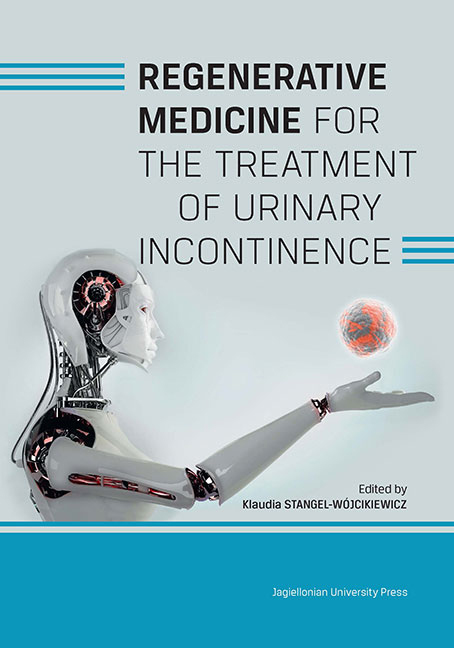Book contents
- Frontmatter
- Contents
- Preface
- Introduction
- Chapter 1 Urinary incontinence in women - outline of the problem
- Chapter 2 Anatomy of the urogenital system
- Chapter 3 Clinical types of urinary incontinence
- Chapter 4 Treatment of stress urinary incontinence
- Chapter 5 Regenerative medicine for the treatment of urinary incontinence
- Chapter 6 Virtual Patient system - simulations of clinical encounters for medical education. Case study of a woman with urinary incontinence
- Chapter 7 Development of a robotic tool aiding a new stem cell-based treatment for stress urinary incontinence in women
- Chapter 8 Difficulties and limitations of cell-based therapy for the treatment of urinary incontinence
- Summary
- List of authors
Chapter 4 - Treatment of stress urinary incontinence
Published online by Cambridge University Press: 03 January 2018
- Frontmatter
- Contents
- Preface
- Introduction
- Chapter 1 Urinary incontinence in women - outline of the problem
- Chapter 2 Anatomy of the urogenital system
- Chapter 3 Clinical types of urinary incontinence
- Chapter 4 Treatment of stress urinary incontinence
- Chapter 5 Regenerative medicine for the treatment of urinary incontinence
- Chapter 6 Virtual Patient system - simulations of clinical encounters for medical education. Case study of a woman with urinary incontinence
- Chapter 7 Development of a robotic tool aiding a new stem cell-based treatment for stress urinary incontinence in women
- Chapter 8 Difficulties and limitations of cell-based therapy for the treatment of urinary incontinence
- Summary
- List of authors
Summary
Noninvasive treatment of SUI
Noninvasive treatment is the cheapest and safest option for female patients. It includes pharmacotherapy, physiotherapy and behavioural therapy (reinforcing certain patterns of behaviour). Mixed UI, with a component of overactive bladder, requires pharmacological treatment with anticholinergic drugs. These substances (e.g. oxybutynin, tolterodine, soliphenacin), by reacting with muscarinic receptors, reduce the number of episodes of urge incontinence and consequently the number of leakage episodes associated with them. Local therapy with oestrogens or hyaluronic acid, by increasing the turgor and tone of vaginal tissues can, to some extent, improve symptoms of urinary incontinence [1]. The isolated type of SUI is treated with duloxetine, a serotonine and noradrenaline reuptake inhibitor. This drug increases neuronal connectivity to the external urethral sphincter and increases bladder capacity by influencing the central nervous system. Duloxetine has been tested in a pre-approval clinical study. Physiotherapeutic procedures are also important in the treatment of mild symptoms of urine leakage. These include electrotherapy, kinesiotherapy and biofeedback.
Pelvic floor training, first described by Arnold Kegel, strengthens the whole system of pelvic floor muscles to restore the normal position of pelvic organs. Therapy should be commenced as soon as the first symptoms of urine leakage occur. The highest success rates of conservative treatment are achieved in stress UI and mixed first- and second-grade UI (80 and 50% positive outcomes, respectively). The described methods require a high level of involvement from the patient and months-long training [2].
Surgical treatment
Surgery is the main method of treating SUI. In 1949 Marshall-Marchetti and Krantz reported a surgical suspension of the bladder neck to the periosteum of the pubic bone [3]. Because of complications, i.e. pubic periostitis, this method has been replaced by more advanced treatment options. In 1961 Burch proposed another surgical procedure in which the urethra and bladder neck are suspended by lifting the perivaginal tissues and suturing them to the Cooper's (pectineal) ligament on either side. This procedure is still considered the gold standard in the surgical treatment of SUI [4–6]. In 1991 Vancaillie reported the first laparoscopic colposuspension. Since then Burch procedures have been performed without opening the abdominal cavity [7].
- Type
- Chapter
- Information
- Publisher: Jagiellonian University PressPrint publication year: 2016



